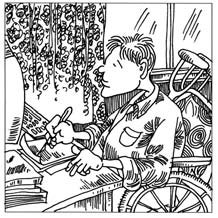Education key to overcoming disabilities
By Pankaj Adhikari (China Daily)Updated: 2007-06-08 06:57
 Poverty, unemployment and illiteracy continue to plague the
nation's people with disabilities.
Poverty, unemployment and illiteracy continue to plague the
nation's people with disabilities.
Part of a vicious circle, according to the national survey conducted last year and recently released, people with disabilities receive less education than their able-bodied peers. Not surprisingly, their family per capita income is less than half the average.
Disadvantages start at birth and continue for life. About 63.19 percent of the 2.46 million children with disabilities go to school, compared with 97 percent of their able-bodied peers. Only 1.13 percent of the nation's disabled have a college education, about a fifth of the national figure of 5.18 percent.
Despite government efforts, a large number of children and young people with disabilities are facing severe challenges. The result of these young people's frustrated ambitions is apparent in the widening gap between those with disabilities and able-bodied young people in terms of confidence, emotional well-being and belief in their ability to shape their own future.
Education is the key to a better and more fulfilling future for both the physically and mentally handicapped. But the number of illiterate people with disabilities aged 15 and over was 35.91 million - 43.29 percent of the total - while the national illiteracy rate was 6.72 percent in 2006, the survey found.
When educational disadvantages are added to physical or mental disabilities, those with disabilities are hardly encouraged to see themselves as valuable members of society.
Public attitudes towards people with disabilities must be changed. They deserve more opportunities to develop their potential. With support and encouragement, they too can contribute to the greater good as respected members of our society.
As more than 75 percent (62.25 million) of the total disabled population in
China live in rural areas, more emphasis must be given to distance learning via
the Internet or TV. This will be of great help because of the freedom it offers
in choosing when, where and how to study. Programs must meet the challenges of
reaching students who may be unable to see, unable to hear or unable to move.

Steps must also be taken for a range of employment options recognizing the diverse needs of people with disabilities. A smooth transition must be ensured from school to work.
Those with physical disabilities have a slight edge over persons with mental disabilities, who face even greater hardships. Steps must be taken to integrate mentally challenged children into mainstream education with the goal of making inclusion a reality for them.
Inclusive education promotes child-to-child learning and participation of parents and community in planning and implementing services for children in general and children with disabilities in particular. The most significant challenge is that education should meet the individual learning needs of all students, handicapped and non-handicapped.
Early intervention is needed to ensure that children who have learning problems receive the help they need before they drop hopelessly behind. Their parents must have access to suitable childcare and should feel confident that their child's needs are being met effectively in school.
Inclusive education stresses child-centered teaching using peer tutoring and group learning.
The urgent task is to change the mindset towards those with disabilities and to train professionals to provide timely intervention. A strong commitment is needed to the rights of all children and young people with disabilities so that they can live confident, fulfilled lives.
E-mail:PANKAJ@chinadaily.com.hk
(China Daily 06/08/2007 page10)
|
|